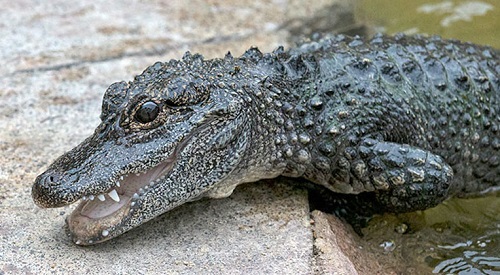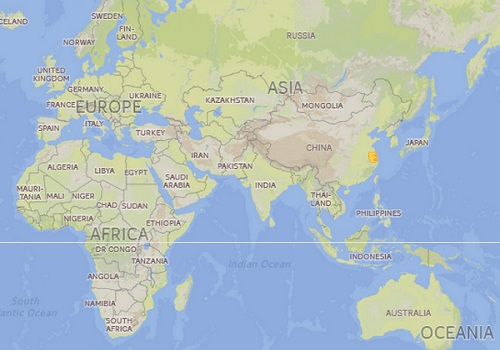Taxonomy
Kingdom |
Phylum |
Class |
Order |
Family |
Genus |
Species |
| Animalia | Chordata | Reptilia | Crocodilia | Alligatoridae | Alligator | Alligator sinensis |
o

A Chinese Alligator from the San Diego Zoo. This species is listed as “critically endangered” by the IUCN Red LIst of Threatened Species.
o
Name
- Common name: Chinese alligator, China alligator, Yangtze alligator.
- Scientific name: Alligator sinensis.
Distribution and Habitat
- The Chinese alligator is one of two species of alligators found in the world, the other one is the American alligator ( mississippiensis) that lives in the southeastern states of the United States.
- The Chinese alligator is confined to a small area in the Yangtze River basin in Eastern China.
- Its habitat includes rivers, streams, swamps, ponds, lakes or any other sources of fresh water.
Physical Features
- The Chinese alligator is the smaller of the two alligator species.
- Its entire body is covered in ossified yellow-gray scales.
- Its upper eyelids have bony plates under the skin.
- They have four short limbs with five partially webbed toes in each limb.
- Juveniles are recognized by yellow bands along their bodies and tails.
- They have a long and thick tail which helps them swim.
- Alligators have strong muscles that close the jaws but weak muscles for opening it. As a result it is relatively easy for a human to keep an alligator’s jaw shut.
Size and Weight
- The average size of a male Chinese alligator from snout to tail is 4.9 ft or 1.5 m. Alligators up to 7.2 ft or 2.2 m long have been recorded.
- Females average 4.6 ft or 1.4 m long. Individuals measuring up to 5.6 ft or 1.7 m have been recorded.
- Adults may weigh up to 88 lbs or 40 kg.
Diet
- Chinese alligators are opportunistic eaters. They generally eat aquatic invertebrates and vertebrates such as crustaceans, worms, fish, insects and snails. They will eat other prey when available such as ducks and rodents.
Behavior
- Adult Chinese alligators are solitary animals except during mating season.
- During the cold months of October to March Chinese alligators brumate, a hibernation-like state, as response to cold weather. They stay in caves or burrows until April.
- During spring and summer they bask in the sun trying to increase their body temperature. Once their body temperature is raised they become nocturnal.
- In the summer they regulate their body temperature by staying in the water, under the shade or under the sun if they get cold.
Reproduction
- Reproductive maturity is reached when they are 5 to 7 years old.
- Females build a mount nest from plants and lay from 10 to 40 eggs from early July to August.
- Eggs hatch in September.
- Incubation period is about 70 days.
Life Expectancy
- In captivity Chinese alligators have lived up to 60.7 years.
Threats
- Their main threat is habitat loss, degradation and fragmentation. Their traditional habitat has been polluted by pesticides and fertilizers or converted to rice paddles driving these animals to ponds and ditches.
- According to the IUCN its population has experienced a decline of more than 80% in the last 45 years.
Conservation Status
- The Chinese crocodile is listed under Appendix I of CITES.
- Chinese alligators, unlike American alligators, are considered “critically endangered” by the IUCN. It is regarded as the most endangered crocodilian of the world.
- According to the IUCN scientists estimate that there are fewer than 130 individuals in the wild but captive populations are healthy.
- The Chinese government has listed this species as a Class I endangered species and receives the highest degree of legal protection.
- The Anhui Research Center for Chinese Alligator Reproduction is the largest facility for the management of this species.
References and further research
National Wildlife Research and Development Center – Chinese Alligator Alligator sinensis
IUCN Red List of Threatened Species – Alligator sinensis
ITIS Report – Alligator sinensis
University of Michigan Museum of Zoology – Alligator sinensis
The Reptile Database – Alligator sinensis
UNESCO – The Alligator Sinensis Nature Reserve
Human Aging Genomics Resources – The Animal Aging and Longevity Database.

